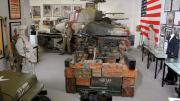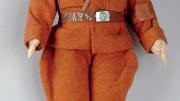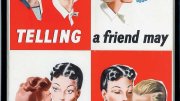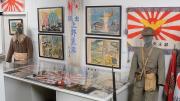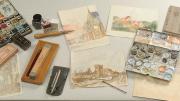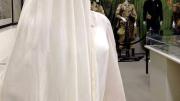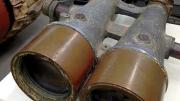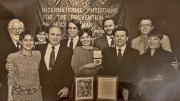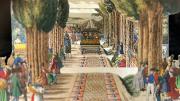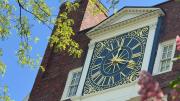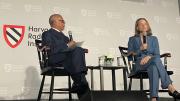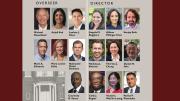During a field trip to The International Museum of World War II in Natick, Massachusetts, a burly high-school junior stopped at the glass case holding Adolf Hitler’s personal effects: pills, powders, and ointments from his medicine cabinet; a silver, monogrammed hand-mirror; and a leather mustache-trainer, worn at night to keep stray hairs in line.
“He said, ‘Ah, I get it now!’” reports director of education Marshall W. Carter, Ed.M. ’97—the student had connected the “personal vanity and megalomania with the dictator.” It’s just the kind of insight that the museum—especially in its planned expansion—should induce. “The opportunity here is to understand that individuals in history had temperaments and agency that were very complex,” Carter adds, “and that those traits ended up affecting millions.”
The museum is a plain, low-slung building off Route 9, behind a Dick’s Sporting Goods. It holds the most comprehensive collection of World War II artifacts in the world. “Other places will have a complete set of guns, or of uniforms,” says Carter, or focus on one nation’s involvement, or historic events, such as the Holocaust. “But what we have is the most global collection—material from every theater, from battlefronts, and home fronts, and no one else has attempted to do that.” Some 8,000 documents and objects are on display, in mind-boggling breadth: from a draft of the 1938 Munich Agreement (with penciled marginalia by Hitler and Neville Chamberlain) and a complete set of plans for D-Day (as well as a map with original notations on landings and units), to explosives disguised as lumps of coal, German enigma machines, a French sewing kit used to relay messages for the Resistance, and the bronze bust of Hitler that General George S. Patton used as a doorstop.
Another half-million items are in storage, including the latest acquisition: the most complete known mobile auxiliary surgical hospital—a 50-foot canvas tent, two operating tables, anesthesia equipment, thousands of instruments. “What’s amazing about it is the atmosphere it creates,” Carter notes. “People entered that tent hanging on to life. And because of the innovation of the MASH, which was new to World War II, many people who would have died were saved and went home.” That mobile hospital will likely be set up in the museum’s pending reincarnation as a two-story, 62,000-square-foot structure (six times its current size) slated to be built and fully open to the public within three years.
Kenneth W. Rendell, who built his career as a dealer in historic documents, began the collection at age 16. Born in 1943, the Somerville native was unusually sensitive to shifting cultural perceptions of the war. “In the 1940s I remember neighbors and friends of my parents coming back, mostly medics from the Pacific, and talking about the horrors,” he says, “but by the 1950s everyone was talking about the glories of war; no one could afford to remember the horrors because they were too devastating. I was struck by this and concerned, even though I was just a kid.” His goal in amassing the ephemera, then and now, is to “save the reality of the war, which reflects the very personal and complex causes and consequences, which were horrible—for everyone.”
By 1999, his private collection had been consolidated at the Natick facility, but was open just to friends, scholars, war veterans and their families, and military personnel. (Longtime trustees include retired four-star general George W. Casey Jr., historian Doris Kearns Goodwin, Ph.D. ’68, and the director of the Churchill Museum and Cabinet War Rooms in London, Phil Reed.) The nonprofit museum was incorporated in 2011, when it started admitting members of the public by appointment. Last fall, Rendell and his wife and business partner, Shirley McNerney Rendell, once a local television news reporter, hired professional senior staff: Carter, formerly the K-8 principal of Milton Academy, and Samantha Heywood, who left the Imperial War Museums to become the founding director and director of exhibits. The museum is expected to stay open throughout construction, which could begin as early as next spring; visit museumofworldwarii.org/visit.html or e-mail museumofworldwarii@yahoo.com to make an appointment.
Just what shape the new museum’s content, design, and narrative structures will take is still a matter for curatorial interpretation. Right now, items are displayed chronologically in some two dozen areas—from “Germany in the 1920s” to “War Trials.”
The white walls are largely covered by ingenious and often vitriolic propaganda posters produced by all the combatants; the rooms are simply lit. The dearth of dramatic display staging and what curators call “didactics” (explanatory texts that guide experience) allows visitors freedom to think about and absorb the staggering volume of materials at their own pace and psychological capacity. Three hours is recommended for a first-time visit.
How to retain “the intimacy of the objects and documents,” given a much bigger space and crowds, “is one of the challenges,” notes Heywood. The greater creative and intellectual puzzle, though, is figuring out how the complex scope of World War II will be conceptualized and tangibly portrayed. What could, or should, be taught? What is most relevant to a wide-ranging contemporary audience, especially to young people, and what might the war mean to them in the future?
For Carter, the museum’s educational power lies precisely in that personal contact and potential for connection with the primary materials of history, including apparent detritus like the bit of tickertape reading, “THE WAR IS OVER.” As the living memory of the war dims, he knows, it is the ephemera that keep history, and its lessons, alive. And so the museum, atypically, allows students and teachers to touch objects: to feel “a soldier’s backpack, the heft of a rifle, or run their fingers along the scarred grooves of a Sherman tank hit by fire, or look through…binoculars that were on the deck of the USS Arizona at Pearl Harbor.” He has already begun building the educational programs, and expects to guide more than 1,500 students through the collection before June.
Even the handwritten documents under glass convey the human touch, he adds, “with the ink and the loops of the cursive letters…and the scratch outs and amendments.” Of the museum’s trove of personal journals, notes, and manuscripts, Dwight D. Eisenhower’s letters to his wife, Mamie, are especially emotional, given common perceptions of the man as the cool-headed supreme commander of the allied forces in Europe. “It is a terribly sad business to tot up the casualties each day,” he wrote on April 16, 1944. “Mothers, fathers, brothers, sisters, wives, and friends must have a difficult time preserving any comforting philosophy…War demands great toughness of fibre—not only in the soldiers that must endure, but in the home that must sacrifice their best.” By revealing the multidimensionality and vulnerabilities of great leaders, Carter hopes that students will more readily explore their own characters—and act on their capacities for empathy, bravery, and even heroism.
Heywood believes war is not inevitable: “It happens because men and women make choices,” she asserts. “The majority of us get along in life without conflict at every turn, and ‘peace’ is the norm for most of us on the planet.” But she also acknowledges that wars will “probably always happen,” and therefore any serious war museum should address “why and how did wars happen, and how and why can they be avoided?”
To that point, the museum’s newest exhibit, on anti-Semitism between 1919 and 1939, opening April 8 at the New-York Historical Society, illustrates the incremental rise of prejudicial hatred. Rare documents are highlighted, but so are items like pamphlets, shop signs, ashtrays, and postcards that Heywood says “helped ‘normalize’ anti-Semitism in German society.” To create the show, she spent months culling through the archives. “A depressing task,” she adds. “But enabling people today to see material like this, knowing what it led to during the war, may lead to them think afresh about discrimination, or about politics today.”
Rendell wants the museum to reflectthe continuing “relevance of this period, 1920-1945.” On the domestic front, he notes parallels between the political mood of 1920s Germany and the “staggering number of disaffected Americans…we have people who are broken and humiliated, who don’t have jobs, and there’s no sense of [positive] nationalism,” he says. “And that is so dangerous.”
In his view, the nation’s current political divisiveness and dysfunction recall the gridlock evident in 1940 in Washington, D.C., when President Franklin Roosevelt was “stuck between the isolationists and the interventionists.” Decisive action occurred only after the attack on Pearl Harbor, and after Hitler and his followers had already wrought unprecedented destruction. “I get really irritated when people talk about how we won the war, when more than 400,000 American soldiers died,” he says. “That’s not winning. We didn’t lose as badly as others—but nobody wins war. And the more the museum can make people aware of that—of the realities of war, of the very serious consequences—the better.”
